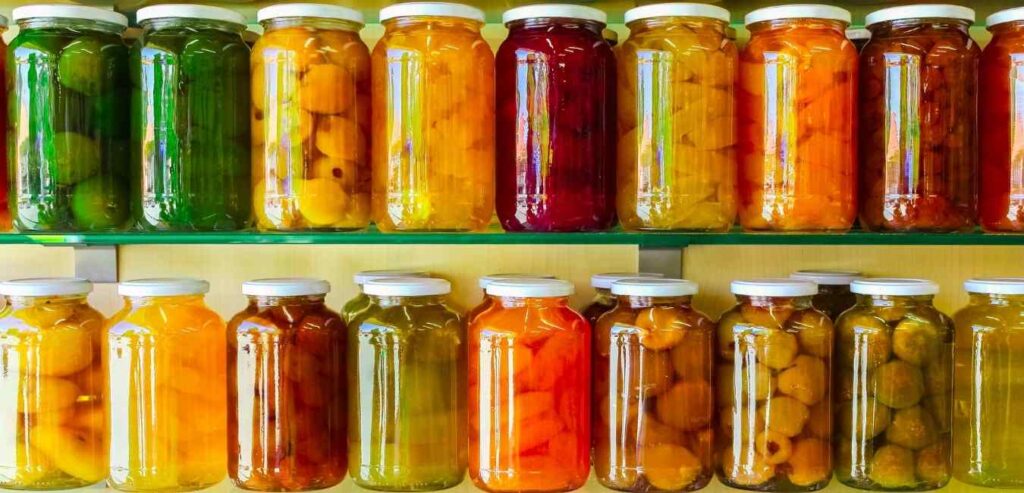Add Canned Fruit from the Grocery Store to Your Home Storage
Canned fruit is an easy food to have and eat in an emergency. It requires no more than a can opener to have ready-to-eat food. Typical canned fruits include applesauce, peaches, pears, apricots, cherries, plums, rhubarb, pineapple, mandarin oranges, and all varieties of berries. Watch for them when they are on sale and stock up. Some parts of the country offer case lot sales and that’s also a good time to add them.
Add Home-Canned Fruit to Your Home Storage
Growing up in the Pacific Northwest, home canning was a late summer/early fall ritual in our home and the entire family was involved in an assembly line. We all picked fruit, and my siblings and I peeled and cut the fruit while my mom put them in bottles and got them ready to process. My dad always joined in, too. The fruit came from our own trees or berry vines, or we bought them from roadside stands or picked them at nearby u-pick orchards or berry patches.
How Much Fruit Should I Store?
Begin by asking yourself a few questions. How will your family have access to fruit in an emergency? Do you anticipate that there will be fresh fruit available grocery stores? Are you able to grow some of your own fruit? What types of fruit will be best for your situation—Fresh? Frozen? Dehydrated? Freeze-dried? Canned? How long a time are you planning for?
One way to determine how much canned fruit you need is to multiply the number of days you are planning for times how many servings per day and how many people.
Formula: (number of days) x (number of servings) x (number of people).
So, if you want two servings a day for four people for one month here is how you calculate it: 30 days x 2 servings x 4 people equals 240 servings. As an example, a quart of applesauce has eight half-cup servings—which would be thirty quart-jars.
Shelf-Life of Canned Fruits
From experience I know that home-canned fruits are best if used in the first year after being bottled. They are still good to eat after the second and third year, but the quality goes down a little each year. They should be stored in a dark, cook location for best quality.
Commercially canned goods will usually have a stamped date which refers to best quality, not safety. If you have canned fruits passed their expiration date, open them and check for yourself if the quality is OK. A bulging or leaking can is a sign of spoilage, so discard it. Be leery of dented cans and check for signs of spoilage.
Home Canning Guides
Home canning is not hard. It requires a few pieces of specialized equipment and the ability to follow directions. I recommend the Ball publications for accurate and up-to-date canning information and tested recipes. In the past they have published the annual Ball Blue Book Guide to Home Canning, Freezing, and Dehydrating. A couple of recent Ball publications are worth considering for your self-reliance library:
Ball Complete Guide to Home Preserving (2020)
My Amazon affiliate: https://amzn.to/3gklsOD
Ball Blue Book Guide to Preserving (37th edition) (2020)
My Amazon affiliate: https://amzn.to/2TlGWBH
Another good place to get accurate and up-to-date canning information is from your land-grant university extension service. Also check out the National Center for Home Food Preservation.
New to Home Canning?
Start with a good canning guide (see above). Next, you will need jars, lids, and rings, along with a funnel, jar lifter, and sharp paring knives. For processing jars of fruit, you can choose either a water bath canner or a steam canner. Water bath canners are traditional for home canning. One newer model is the McSunley Water Bath Canner. It has a flat bottom so will work on gas, electric, and glass stove tops. (My amazon affiliate link is https://amzn.to/3iEB2Go.) Steam canners are a faster way to process home canned fruits because they don’t require heating up a big pot of water. Roots and Branches offers one. (My Amazon affiliate link is https://amzn.to/3wpKDEX.)
Shortage of Canning Supplies
With the COVID pandemic and people’s heightened awareness of the need to be prepared, plus some breakdown in the supply chain, canning jars and canning lids were (are?) hard to come by during the harvest season last year. If you can find lids, don’t hesitate to stock up on what you need for this year’s canning season.


